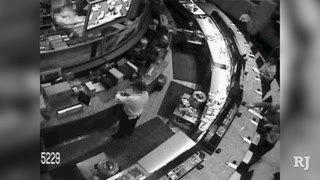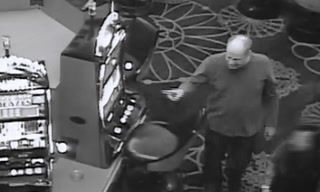MGM video of a luggage handler loading Stephen Paddock’s luggage.
MGM video of Stephen Paddock interacting with an employee while waiting for an elevator.
MGM video of Stephen Paddock driving his vehicle from self-park to valet.
Surveillance video of Stephen Paddock interacting with the VIP desk at the MGM.
Surveillance video of Stephen Paddock in the MGM in the days leading up to the October 1 shooting.
Surveillance video of Stephen Paddock in the MGM in the days leading up to the October 1 shooting.
Surveillance video of Stephen Paddock in the MGM in the days leading up to the October 1 shooting.
Surveillance video of Stephen Paddock in the MGM in the days leading up to the October 1 shooting.
A short compilation of footage of Stephen Paddock bringing luggage into Mandalay Bay and gambling in the resort casino. MGM Resorts.
Elaine Wilson talks to Henry Brean and Briana Erickson about the story of survivors reconnecting after the births of children.
Las Vegas police are searching for a suspect and his 2-year-old child after a shooting Tuesday night at an apartment complex on South Decatur Boulevard.
Elaine Wilson talks to Nicole Raz about the Las Vegas Victims’ Fund being disbursed, how much the money will help and how the fund compares to previous mass shootings across the country.
Las Vegas resident Colie Knoke was the first to receive a check, for $1,924. Route91Strong gave out $3,924 at an event at a home in Summerlin. Nicole Raz Las Vegas Review-Journal
Las Vegas Strip shooter Stephen Paddock had anti-anxiety medication in his system, autopsy records obtained Friday by the Review-Journal show. The autopsy report also confirms Paddock died of a self-inflicted gunshot wound to the head. Clark County Coroner John Fudenberg said in December that the 64-year-old Paddock, a high-rolling video poker player, committed suicide. He shot himself as officers closed in on his hotel room after he stopped firing at the Route 91 country music festival across the street from the Mandalay Bay. The Review-Journal reported several days after the mass shooting that a local doctor had prescribed the anti-anxiety drug diazepam, known by the brand name Valium, for Stephen Paddock back in June. After Paddock’s body was cremated, Fudenberg last month released the remains to his younger brother Eric Paddock, who lives in Orlando, Florida. Eric Paddock flew to Las Vegas to pick up the ashes after he was unable to get the coroner’s office to send him the remains. He told the Review-Journal that he does not intend to keep his brother’s ashes at his home in Orlando.
Las Vegas Strip Bus Drivers Share Their Experiences From The Oct. 1 Shooting
A judge on Friday ordered the Las Vegas Review-Journal and other media outlets to destroy a copy of the autopsy report of an Oct. 1 mass shooting victim, siding with the privacy concerns of the victim’s widow. The report was one of 58 that a different judge ordered the Clark County coroner’s office to release last week to the newspaper in the wake of another lawsuit, which argued that the autopsies of the Las Vegas mass shooting victims should be public. That judge also ordered the coroner’s office to release gunman Stephen Paddock’s autopsy, which has not been handed over. Friday’s ruling pertained only to the autopsy report for Charleston Hartfield, a Las Vegas police officer who was killed during the mass shooting. He was the husband of the plaintiff, Veronica Hartfield. The ruling by District Judge Richard Scotti also barred the newspaper from further reporting on Hartfield’s autopsy details. Review-Journal Editor in Chief Keith Moyer said the company would file an emergency appeal of Scotti’s decision to the Nevada Supreme Court. “These reports are important public records. Previous rulings have held that these records must be accessible to the public,” Moyer said. Scotti’s decision came after more than two hours of arguments, during which attorney Anthony Sgro argued that the widow’s privacy concerns far outweighed the public’s need to know. He also said the Review-Journal only sought the records in the first place “to sell newspapers.” The newspaper’s attorney, Maggie McLetchie, said Sgro’s comments were “strange criticism.” She argued that despite the anguish Hartfield’s widow and other victims’ families have experienced in the wake of the Oct. 1 massacre, the First Amendment still applied. After the judge’s ruling, McLetchie reiterated that the autopsy reports were partially redacted, and that the Review-Journal has no way of knowing which report was Hartfield’s. Scotti said the newspaper can either hand over all 58 autopsy reports to the coroner’s office and receive 57 back, or allow the office’s staff to come to the newsroom and select the document to destroy. “That’s a preposterous demand of a free press,” Moyer said. “This isn’t North Korea. Government officials cannot enter a newsroom and forcibly remove public records, even under a so-called court order.” Contrary to the assertion that the Review-Journal is seeking the information exclusively to sell newspapers, the editor in chief said, the Review-Journal is investigating the police and medical response to the mass shooting. “Autopsy reports are essential to uncovering potential shortcomings in the response and the Oct. 1 investigation, holding institutions accountable for those failures and ensuring authorities can take steps to make sure they aren’t repeated during future tragedies,” Moyer said. “Autopsy reports also help the public evaluate the competency of the coroner’s office, which is certainly in question.”
Assistant Sheriff Charles Hank meets with members of the media to discuss additional details about the officer involved shooting that occurred on February 6, 2018. (Las Vegas Metropolitan Police Department)
Several RTC bus drivers were near the Las Vegas Village when Stephen Paddock began firing upon Route 91 concertgoers. They share their experiences. )Patrick Conolly/Las Vegas Review-Journal/Footage provided by Keolis Transit)
Review-Journal reporters Elaine Wilson, Jeff German and Rachel Crosby go over the new developments surrounding Douglas Haig and casino security measures.
Douglas Haig, the man who was identified this week as a “person of interest” in the Las Vegas shooting investigation, said Friday that he does not believe the tracer ammunition he sold to gunman Stephen Paddock was used in the mass shooting. (Ross Leviton/Las Vegas Review-Journal)
Douglas Haig, identified as a person of interest in documents related to the Las Vegas shooting, spoke to reporters Tuesday evening outside his home in Mesa, Arizona. (Madison Miller/Las Vegas Review-Journal Correspondent)
Elaine Wilson talks to Jessie Bekker about how a miscommunication on the night of the shooting led to patients being diverted from University Medical Center.
On October 1, 2017, over 22,000 people came together to enjoy a country music festival in Las Vegas, Nevada. On the final night of the festival, a lone gunman opened fire into the crowd from the 32nd floor of the Mandalay Bay Resort and Casino. The LVMPD Preliminary Investigative Report reveals more information about the timeline of the shooting and Stephen Paddock.
Review-Journal reporters Elaine Wilson, Rachel Crosby and Colton Lochhead discuss the new details revealed during a press conference on the Las Vegas mass shooting.
Lombardo: “We do not anticipate charges against Marilou Danley”
Crime scene photos contained in the preliminary report on the Oct. 1, 2017, shooting in Las Vegas show the hotel room used by gunman Stephen Paddock at Mandalay Bay on the Strip.
Elevators at Mandalay Bay are again stopping at the 32nd floor after a pause at the end of last year.
Mandalay Bay closed off a few floors starting in late November amid a guest slowdown caused by the combination of the holiday season and fallout from the Oct. 1 mass shooting.
The Las Vegas Victims’ Fund is a 501(c)(3) nonprofit that was set up on behalf of Clark County to accept money for victims of the Las Vegas shooting. 100% of donations to the Las Vegas Victims’ Fund will go to three categories of victims.
































